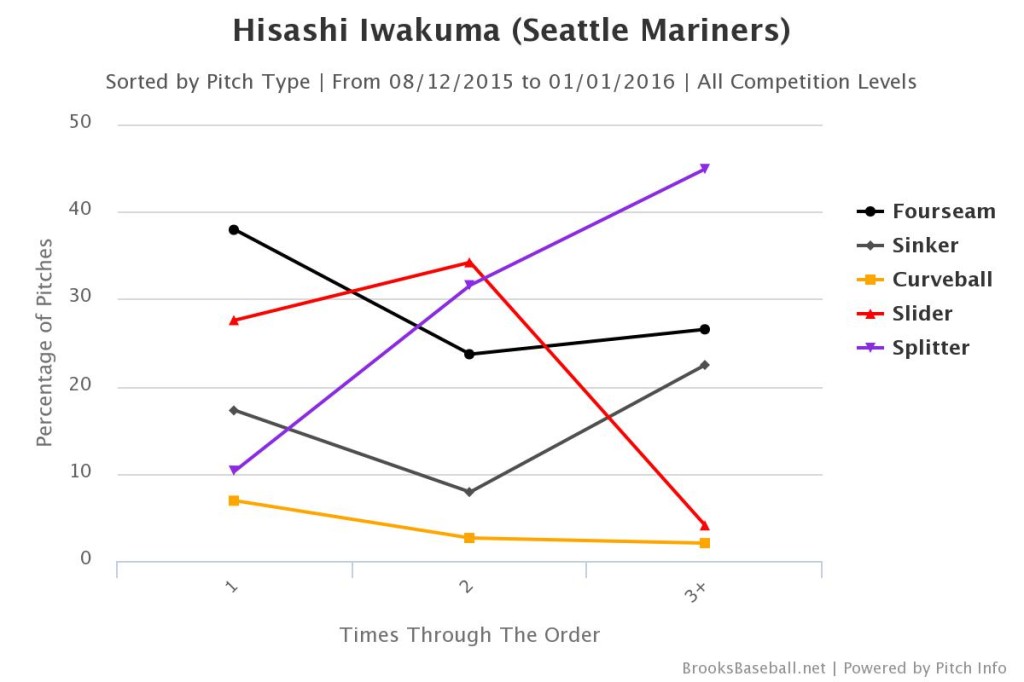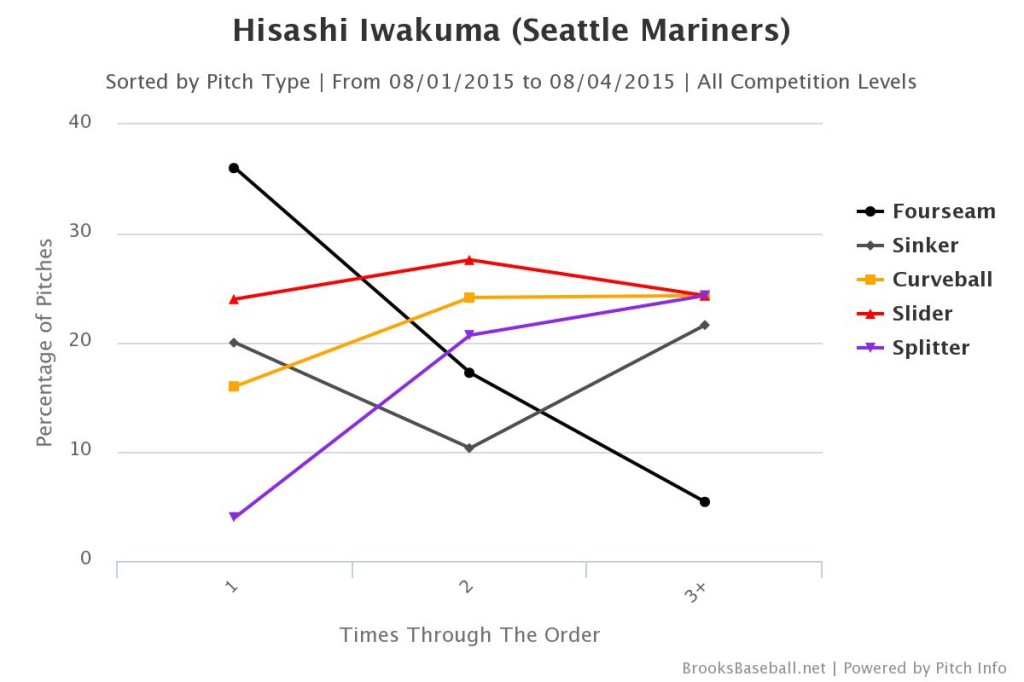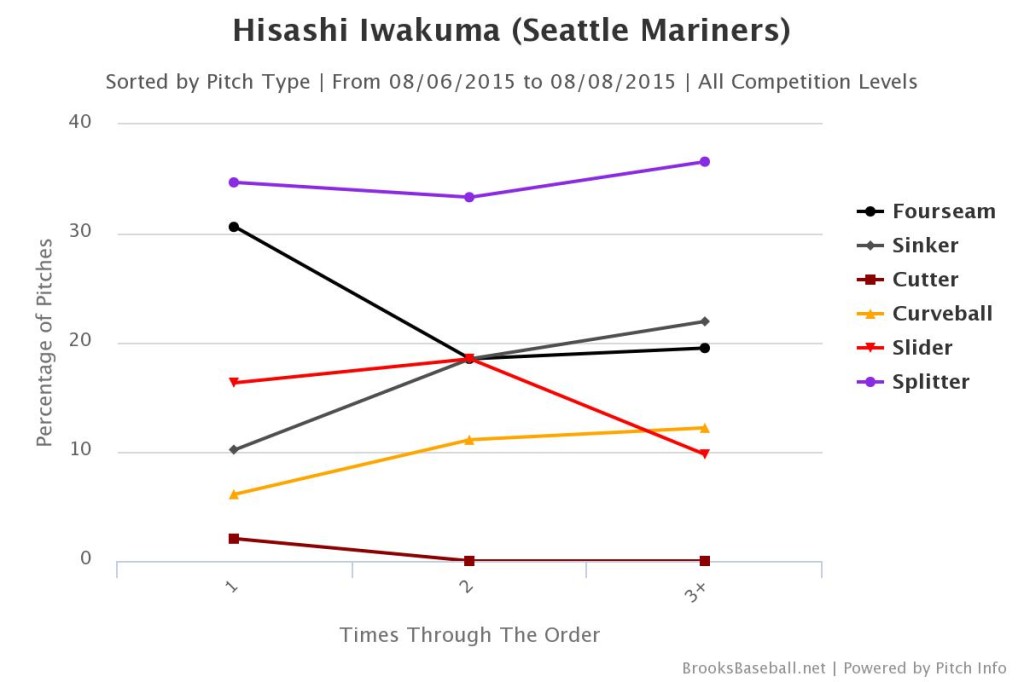Kuma/Sucre and Learning How to Be a Junkballer
Hisashi Iwakuma’s no-hitter was a perfect example of a pitcher using unpredictability as a weapon. As Jeff’s great post at fangraphs shows, Kuma essentially used three different approaches – a fastball/slider-heavy look in the early-going, then splitters/breaking balls in the middle innings, followed by fastballs and splitters exclusively down the stretch. In the postgame show, Shannon Drayer asked Hisashi about his slider usage, noting that he threw more of them than normal. And many on twitter pointed out that he threw more *splitters* than normal. Both are true, but it was *how* and *when* he used them that set this new, junkballing version of Iwakuma apart.
Hisashi Iwakuma’s splitter is, of course, his best pitch. The split is exceedingly difficult to lay off of, as evidenced by Iwakuma’s career 60%+ swing rate on the pitch. But because of its movement, he doesn’t need to throw it in the zone to get strikes, and that’s how you get this:
Threw season-high 33% splitters today (38 total). 35 of 38 in lower third of zone or below. Via @ESPNStatsInfo https://t.co/EK0OkQjdsb
— David Schoenfield (@dschoenfield) August 13, 2015
The lower a pitch comes in, the more likely it’ll be put on the ground (if it’s put in play). And as you’d expect, Iwakuma has a GB/FB ratio on his splitter over 7:1 for his career. Iwakuma isn’t the only guy with a good split, of course. Matt Shoemaker of the Angels gets an even higher swing rate. Masahiro Tanaka gets a very high swing rate and a better-than-Kuma whiff rate. Nate Eovaldi gets a ridiculous GB/FB ratio. But Iwakuma’s combined these attributes extremely well, and it’s allowed him to be consistently effective even in his mid-30s.
In addition, because the pitch does what it does, it allows Iwakuma to be remarkably consistent *within games*. As you know, the “times through the order penalty” is fairly large, and it’s consistent; really good pitchers face it, as do AAAA scrubs – it’s there in day games as well as night games, etc. Throughout his career, Iwakuma has a .666 OPS-against the first time through the order, and that drops to .643 the second time through, and stays at .648 the third (the OPS-against plummets the 4th time through, but he hasn’t done that much). FIP is not the only sabermetric “rule” that Iwakuma flouts.
Hisashi Iwakuma has been pitching here for years now, and you’d expect to see batters make some adjustments. What we’ve seen, though, is that batters haven’t needed to thanks to the weakness of Iwakuma’s breaking balls. His slider stood out as his worst pitch of all, but instead of scrapping it, he’s made some minute tweaks (as in: I can’t discern anything in its velo/movement). What’s different is that he’s controlling the pitch a bit better. He’d back-door lefties with it and occasionally try and sneak a strike to righties, but hitters by and large destroyed the pitch, particularly if it was thrown within the zone. Over the past month or so, he’s thrown it for a ball less than 1/4 of the time compared to over 1/3 of the time in 2015 overall and 32% for his career. The ratio of called strikes to called balls on the pitch is now 2nd highest in the league, behind Felix – another guy who uses his change-up as his chase pitch.
So the tweaks to his mechanics, if he’s made any, may have helped. But they seem too subtle to turn a pitch’s results from utter garbage to useful, nearly overnight. This seems like a case where sequencing is playing a role, and that’s why the pattern Jeff pointed out is so interesting. In the early part of the game Wednesday, Kuma threw tons of sliders, then replaced them with splitters late. Both pitches have very similar vertical movement, but the slider is, for whatever reason, easier for batters to identify. Thus, in the early going, Iwakuma was giving up plenty of contact. 4 of the first 6 batters put sliders into play, and batters put sliders into play more often than any other pitch on the day. It may – may, this is speculation – also have helped Iwakuma’s splitter play up in the late innings – after seeing another pitch with drop thrown *in* the zone early, it may have made the splitter even harder to lay off than normal.
Here’s what Hisashi’s pitch mix looked like on Wednesday:

And here’s what it looked like the other day against the Twins – a game which was *nearly* Iwakuma’s first ever CG.

It’s a slightly different pattern, as in that case he used his four seam early, before swapping it out for sinkers and splitters late, but you get something of the same pattern – using the splitter later and trying to confound the scouting report early on.
That contrasts with something like this, which was his game against Texas in between the two games above:

Here, the splitter usage is a constant. There’s some change going on with four- and two-seamers, but it doesn’t jump off the page. So what’s the difference here? Well, there are many – different opponents, different day (maybe his slider was garbage during warm-ups), lots of things. But one difference was his catcher. For the Twins and O’s games, Sucre caught Iwakuma, while Zunino handled the game in between. This is really, really tentative and I’m hesitant to even bring it up given Zunino’s offensive struggles, but thus far, Iwakuma has fared much better when Sucre’s calling the pitches. Over Iwakuma’s career, he has the highest K:BB ratio when Zunino’s behind the plate. But he’s also given up HRs on over 3.5% of his PAs, leading to a high SLG%-against. Sucre’s caught Kuma far, far less, but batters are slugging .259 against Kuma in those games, as opposed to the .423 they’re slugging when Zunino’s calling pitches.
This would just be noise if we didn’t see some kind of evidence that they call games *differently*. Even that is complicated by the fact that Sucre’s caught so few, and he’s been behind the plate for some shaky starts – and starts in which the pitch mix doesn’t move the way it has this month. It’s possible this is a fluke, and it’s possible Sucre’s figured something out. If he has, there’s nothing preventing the M’s (or Sucre) from telling Zunino. It’s also possible that this is *Iwakuma’s* doing – that he’s told his catchers he’d like to throw the slider early to get a feel for it. In any event, it’ll be interesting to see if Iwakuma stays with Sucre the rest of the way, and if his pitch mix strategy evolves. For now, though, Sucre and Iwakuma seem to have come up with a way to confuse hitters and scouting reports all without throwing fewer splitters.
Comments
2 Responses to “Kuma/Sucre and Learning How to Be a Junkballer”
Leave a Reply
You must be logged in to post a comment.

Personally I am not all that interested in pitch selection, but I like that marc likes it so much, so I liked reading this.
Interesting article, Marc – especially the speculation towards the end regarding *why*.